Le salon par excellence is, indeed, a work of art, awash in France’s storied culture and splendid architecture. Often, however, it is a setting’s tangible links to caring ancestors who lived centuries apart that make the most abiding impression.
Unlike family castoffs that dwell in stateside homes only until we can afford to replace them, the French savor the pleasure and prestige of furnishings that come their way, thinking of themselves as stewards of the past entrusted with pieces of history fit to reign forever in the most coveted spots.
But, then, who could begrudge an armoire—the celebrated source of Gallic pride—such regal treatment? Built in the thirteenth century for storing armor, then housing an entire family’s clothes and other sparse possessions, the armoire has risen to iconic social status since becoming emblematic of French country life. (Closets were not common in dwellings until the twentieth century.) Variations abound, so comparisons are inevitable, of course. And, certainly, some do stand well above the fray. Most prized of all are those with deep carving, shaped bonnets, piercings and the patina of age—the distinctive luster resulting from centuries of exposure to heat, humidity and light, to say nothing of oil from loving hands, being that the first thing people often do is touch a piece of furniture.
Yet the consensus is that looks are not everything. Whether modest or magnificent, the point of pride confirming value and status is provenance—a document authenticating origin and chronicling previous ownership, including identifying the experts who have vetted the piece in the past. Even an armoire that might not ordinarily merit a second look commands respect when accompanied by a paper trail of its meanderings. Then, too, any tale—real or far-fetched—adds immeasurably to the cachet, readily enhancing its worth.
No matter that an armoire may unavoidably overshadow other elements in the room. For centuries, the French have favored large-scale furnishings of noble proportions. And how could it be otherwise? As large châteaux throughout France have given rise to smaller maisons and less-spacious appartements, it stands to reason that furniture would still have the imposing look expected when the custom of handing down family heirlooms remains unchanged.
Predictably, then, the armoire isn’t the only heirloom reestablishing its preeminence. Rock crystal (colorless quartz) chandeliers, trumeaux (painted overmantels) and screens with painted scenes help steep settings in mystique. Meanwhile, densely woven tapestries peering down from walls paint salons with further importance. Traditionally, mirrors add drama, radiate luxury and magnify square footage with ease, whether resting comfortably on fireplaces or not. Here are more guidelines to stylish salons with pared-down glamour in keeping with the mood of today:
F In those salons that want for nothing, chairs of different sizes and ages are telltale signs that settings have evolved over time. Strictly speaking, there is an unwritten rule requiring an equal number of places in the salon as in the dining room so guests can debate the merits of a recent film if not participate in political discussions, even after a lingering meal followed by dessert. For one to simply pick up and leave without engaging in further discussion is considered socially incorrect, as then a dinner party is thought less than successful. Obviously, to do as the French do one can always import chairs from the dining room to accommodate guests and keep the conversation flowing.
F In bygone eras, imperial-looking récamiers (reclining chaises with one end slightly taller than the other and gracefully curved; named for Mme Récamier), settees, bergères (fully upholstered armchairs with enclosed sides and exposed wood frames) and fauteuils (upholstered armchairs with open sides) stiffly hugged the perimeter of a room. These days, artfully grouped seating—including ottomans and chaise longues parked in front of fireplaces—make it easy for people with an appreciation for the decorative arts and a passion for intellectualizing to discuss most anything, including pressing concerns. Ingrained in polite society is an aversion to talking about personal finances or materialist attachments, however. And never would one ask others what they do for a living.
F While some people prefer letting bare parquet de Versailles or stone put on their own floor show, others are drawn to the beauty of hand-loomed orientals. Purists, though, favor timeworn Savonnerie area rugs, once woven for royalty, and faded Aubussons with their tapestry-like weave, as these add an air of dignity. Those rugs passed down through the ages are welcomed regardless of size. Stewards of French history disregard the stateside practice of leaving eight to eighteen inches of exposed wood around the perimeter of a room. Instead, ample-size area rugs cross boundary lines, making smaller carpets appear skimpy—and rooms look larger than they are. (No matter if a rug sprawls into the traffic path.)
F Yet, with the country’s 8.8 million dogs clearly having the run of houses, practicality is often a weighty consideration influencing design choices. Scores applaud durable sisal, though it doesn’t react well to water. In fact, water can leave bleach-like blotches on some sisals. Humble jute, coir and sea grass—used for centuries—also epitomize today’s easy ways and do not react adversely to water. Not everyone loves natural grass rugs, however. Dozens find the texture too abrasive for bare feet and infants’ knees, causing it to lose some of its cachet. All steer clear of wall-to-wall carpeting.
F Tailored slipcovers with couture-inspired detailing—piping, corner pleats and flat rather than frilly skirts—aim to protect seating, with luxurious fabrics hidden underneath. For that matter, they also camouflage weary furniture, giving pieces a fresh look far less expensively than replacing or reupholstering tattered textiles. At their intimate best, they add polish to looks by fitting sofas, chairs and ottomans perfectly.
F With strong, stately architecture—the foundation and framework of French pride—graciously scaled salons echo with cherished, avidly collected antiques, faithfully honoring the Republic of France. Even in close quarters, the French think big, opting for a few furnishings, always exaggerated in size rather than modestly scaled.
F Still, unassuming elegance must mingle with ease. So even tightly edited spaces host heroic-sized family portraits, photographs in frames, pillows, throws, candles and freshly cut flowers arranged en masse. Heaped high on coffee tables roomy enough to hold chessboards are well-read books. Often noticeably absent, however, are plants, as many feel they should be relegated to outdoors.
F Sturdy but shapely side tables that withstand the rigors of playful, ever-present dogs offer places for glasses of France’s prestigious wines and plates of the country’s endless varieties of cheese. Always there are plump pillows stitched from vintage textiles to rest against and supple throws that look equally pretty front and back draped romantically, not by chance.
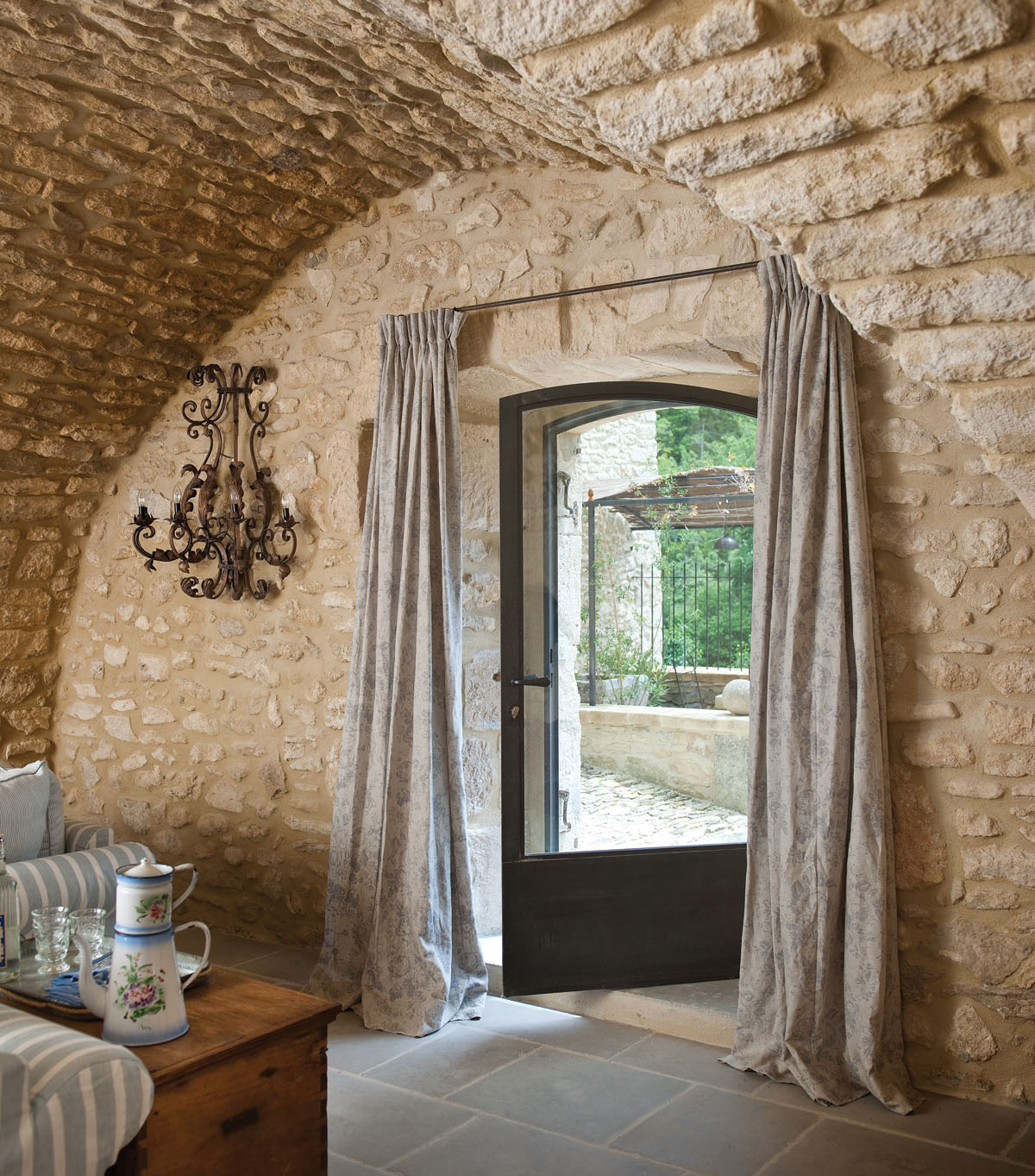
Time-honored Bennison—with its textiles borrowed from eighteenth- and nineteenth-century pattern books—gracefully flanks the door. The sconce is original to the bastide. The painted tin coffee pot is mid-century (about 1950).

In a family living area where the palette doesn’t stray from neutrals, frills are kept to a minimum. Against the limestone fireplace leans an antique bellows.

When it comes to integrating architecture and design, the French seemingly come by the trait naturally. The chandelier’s stately scale is in keeping with the grandeur of the ceiling height.

Chimes that once welcomed worshippers gathering for church services now announce dinner at the Bastide de Sivergues, minutes from Apt in the Luberon Mountains.

An early-twentieth-century cupboard adds to the old-world panache of the nineteenth-century bastide. No matter that many people are moving from large châteaux to homes more manageable, sought-after eighteenth-century furnishings, once in ample supply, are increasingly difficult to come by.

A kitchen dons a modern bent yet preserves its architectural strength, albeit rearranged. As if indifferent to changing times, the room remains on the ground floor, much like servants’ kitchens in earlier eras that were far from dining rooms to avoid scattering fires, sounds and aromas. The countertop here is easy-to-maintain quartz, which is harder than marble, thus more durable. Cuisines Fabre in Robion, France, fabricated the cabinets.

Personifying the spirit of Provence, street markets brim with handpicked vegetables, fruits and flowers in addition to fish, meat, cheese and pasta. Electrical outlets—recessed in the quartz countertop—are ready to be of service.
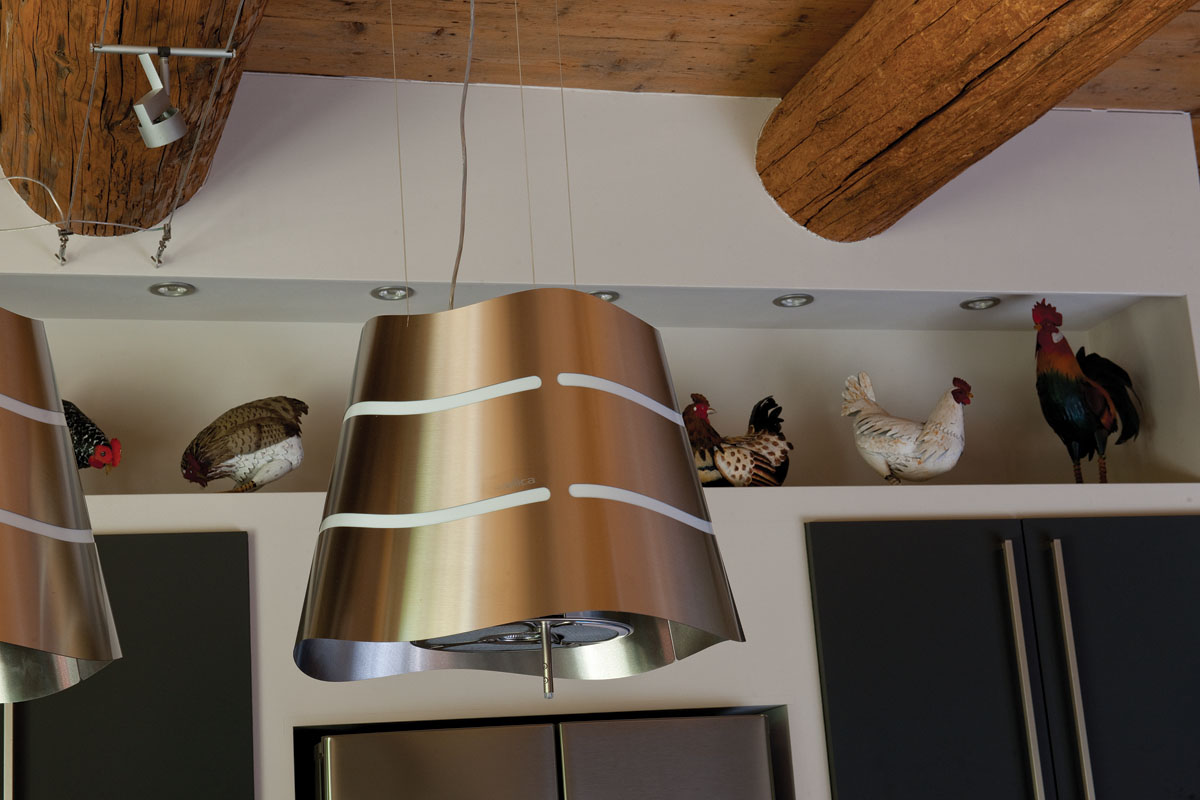
Let there be statement-making lighting over the kitchen island. Wave lights from the Italian company ELICA house an extractor fan, while a flock of brightly colored, hand-painted chickens perch above appliances, adding a little fun, to say nothing of a decorative accent. On a rooftop terrace at Versailles, Louis XV installed an aviary so he and Madame de Pompadour could indulge their passion for raising chickens and other birds.

Above and below: With centuries of expertise, France continues to be the world’s leading producer of fine wines. While most on this side of the Atlantic follow the old rule “red wine with meat and white wine with poultry and fish,” the French drink red wine with all but seafood. What’s more, they attribute both their life expectancy of 82 and low rate of coronary heart disease to quaffing down wine with meals.
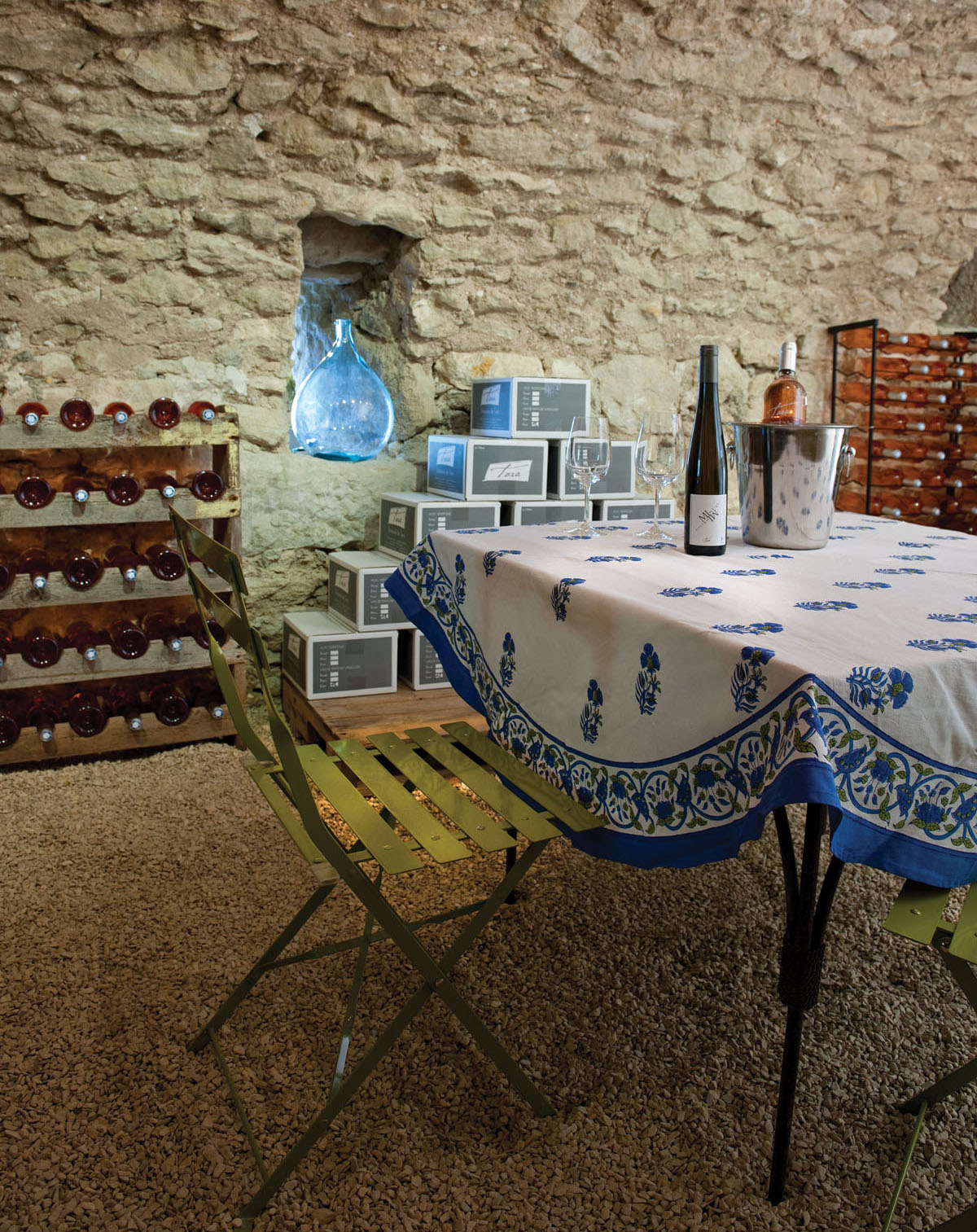
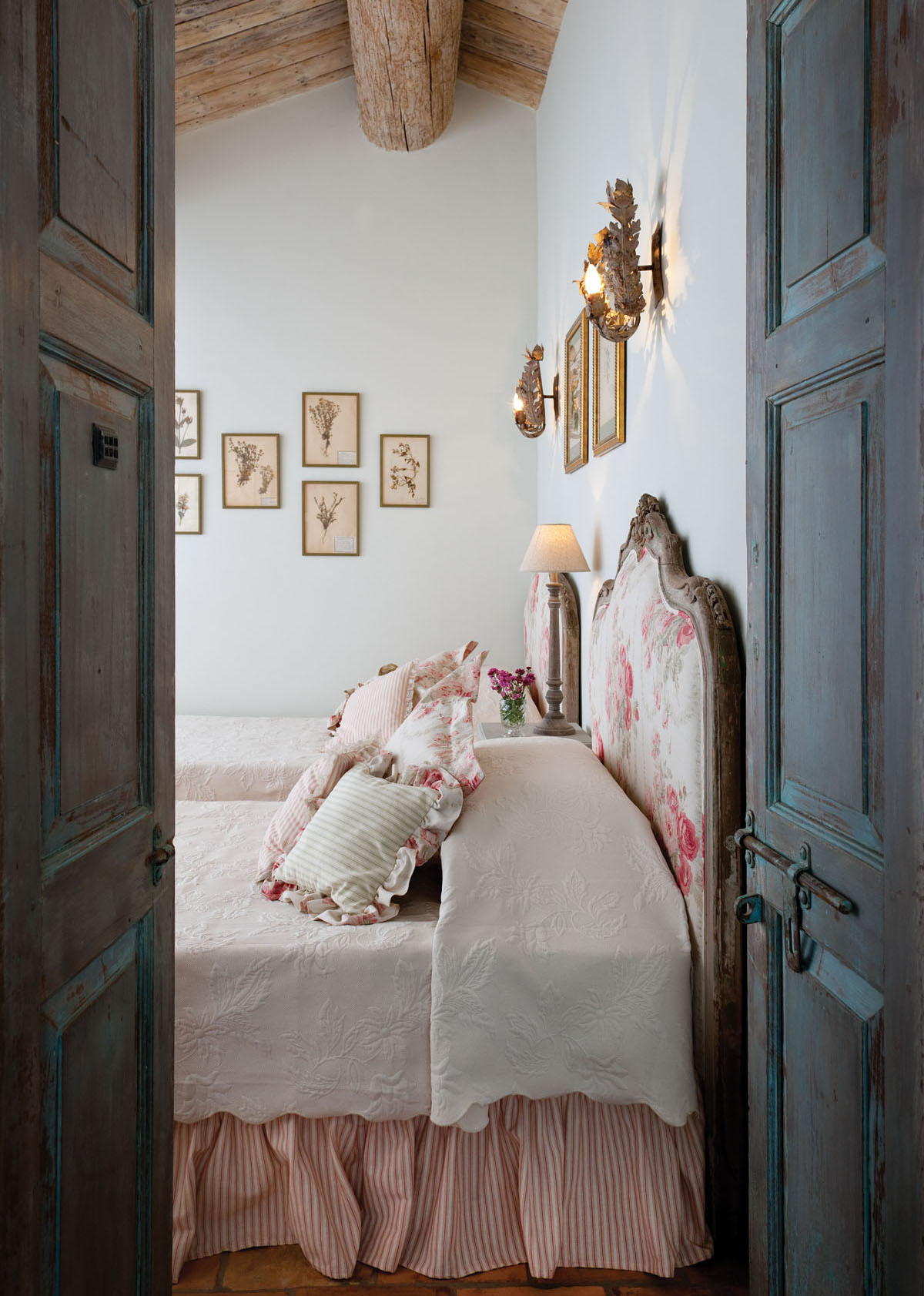
Botanicals add to the charm of a guest room with headboards upholstered in Bennison Fabrics. Bed skirts wear a modest ticking stripe. Once, tightly woven ticking was the traditional covering for French mattresses stuffed with cotton and horsehair; the stripes hid imperfections in the weave. Nowadays, however, the fabric is no longer bedridden. Rather, it traverses everything from upholstery to lamp shades.

Light pours from the entry into the upper hall, where an eighteenth-century trumeau (painted overmantel)—a mainstay in many French homes—hovers over a tufted bench covered in biscuit linen.
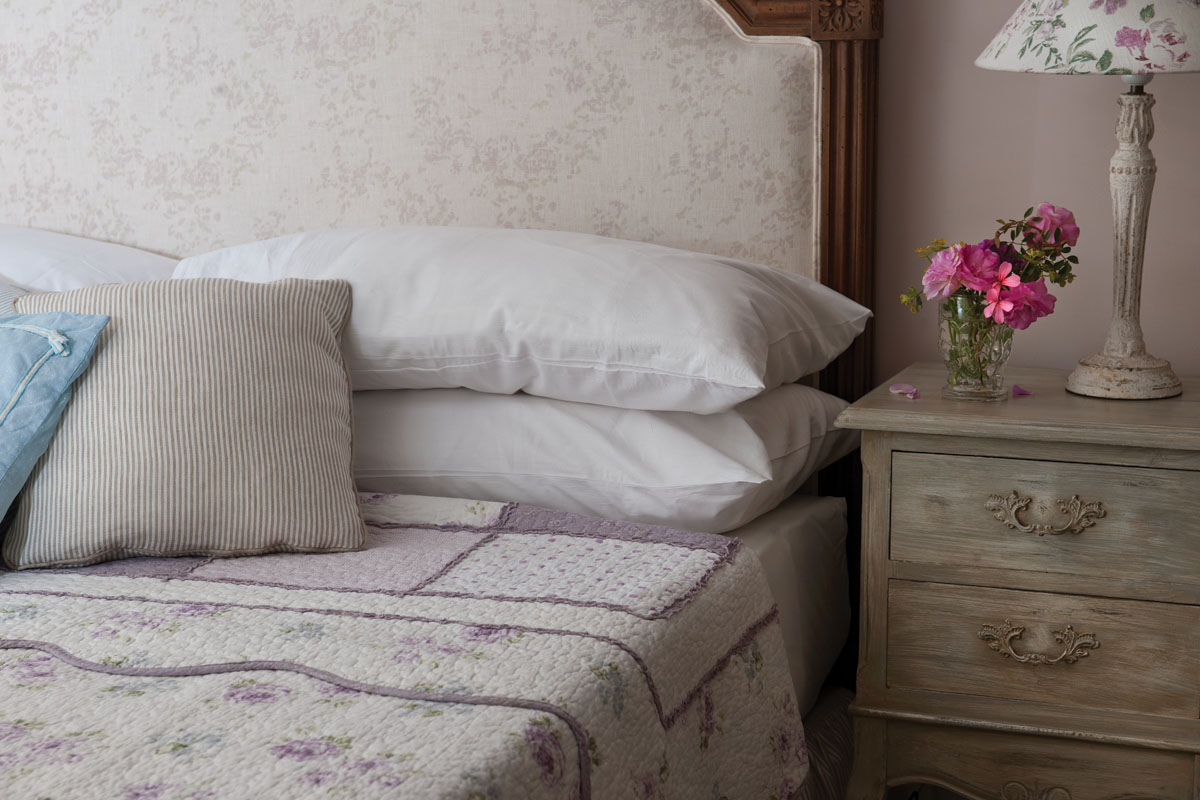
In Provence, antique embroidered quilts pass from one generation to the next. And in families not blessed with inherited ones, new boutis with heirloom potential are wished-for gifts. The art involves hand sewing together two large pieces of cloth and then filling the coverlet with batting, rather than piecing together disparate fabrics to transform the quilt into the sculptural form with which we are familiar.

Blue crystals echo a hue in the room, making the fixture a perfect complement. The late-nineteenth-century chandelier is from the Paris flea market.

Louis XVI was the first French king to enjoy a bathroom with a deep soaking tub—as not until the mid-eighteenth century did rooms at Versailles accommodate bathtubs. Tile takes its color cue from the toile. Toile-de-Jouys originated in the town of Jouy-en-Josas, near Versailles, 250 years ago. Generally, monotone, most were printed in red, blue, green or black on white or off-white ground.
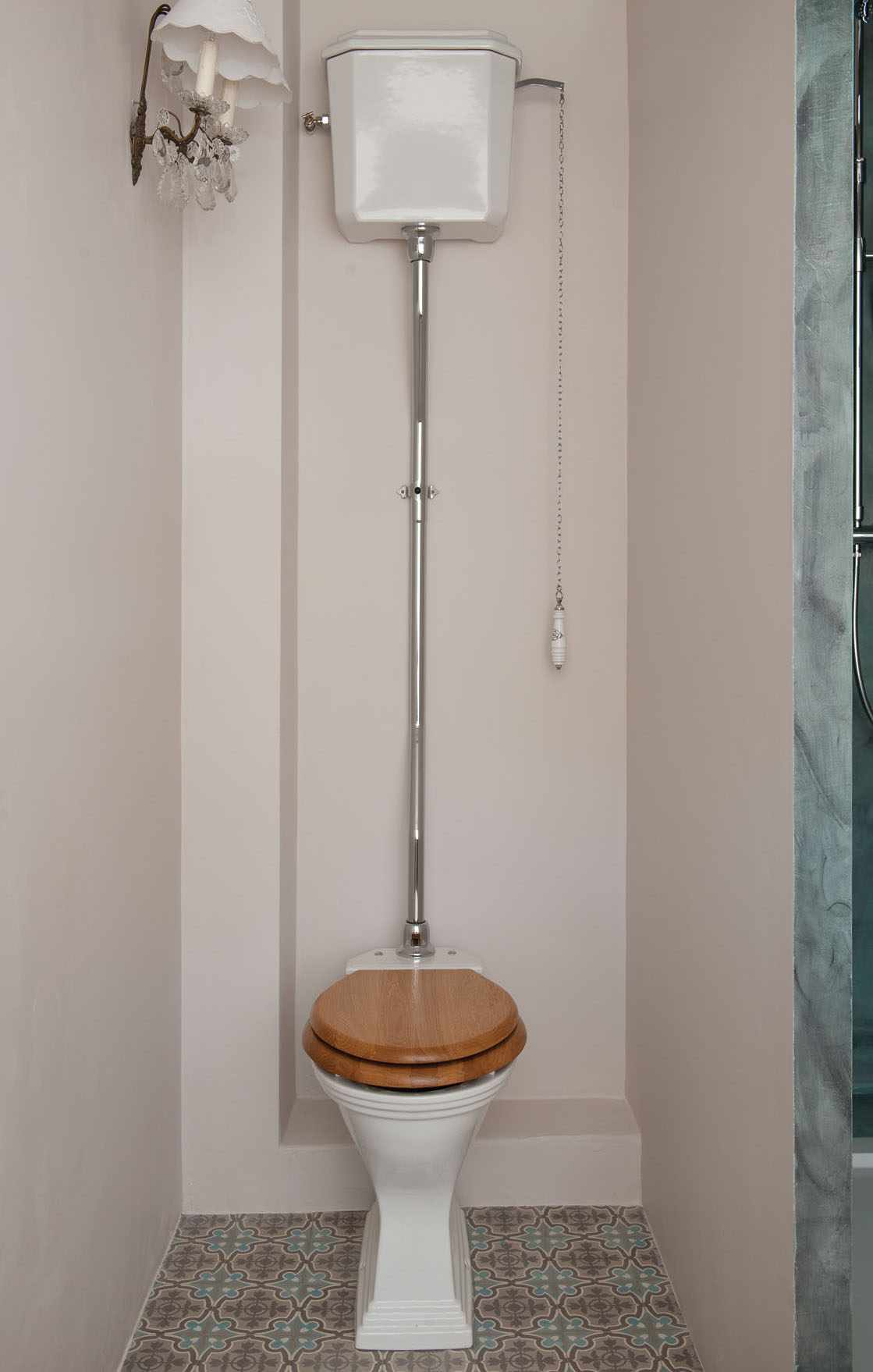
Water closets in French hotels often evoke the past.
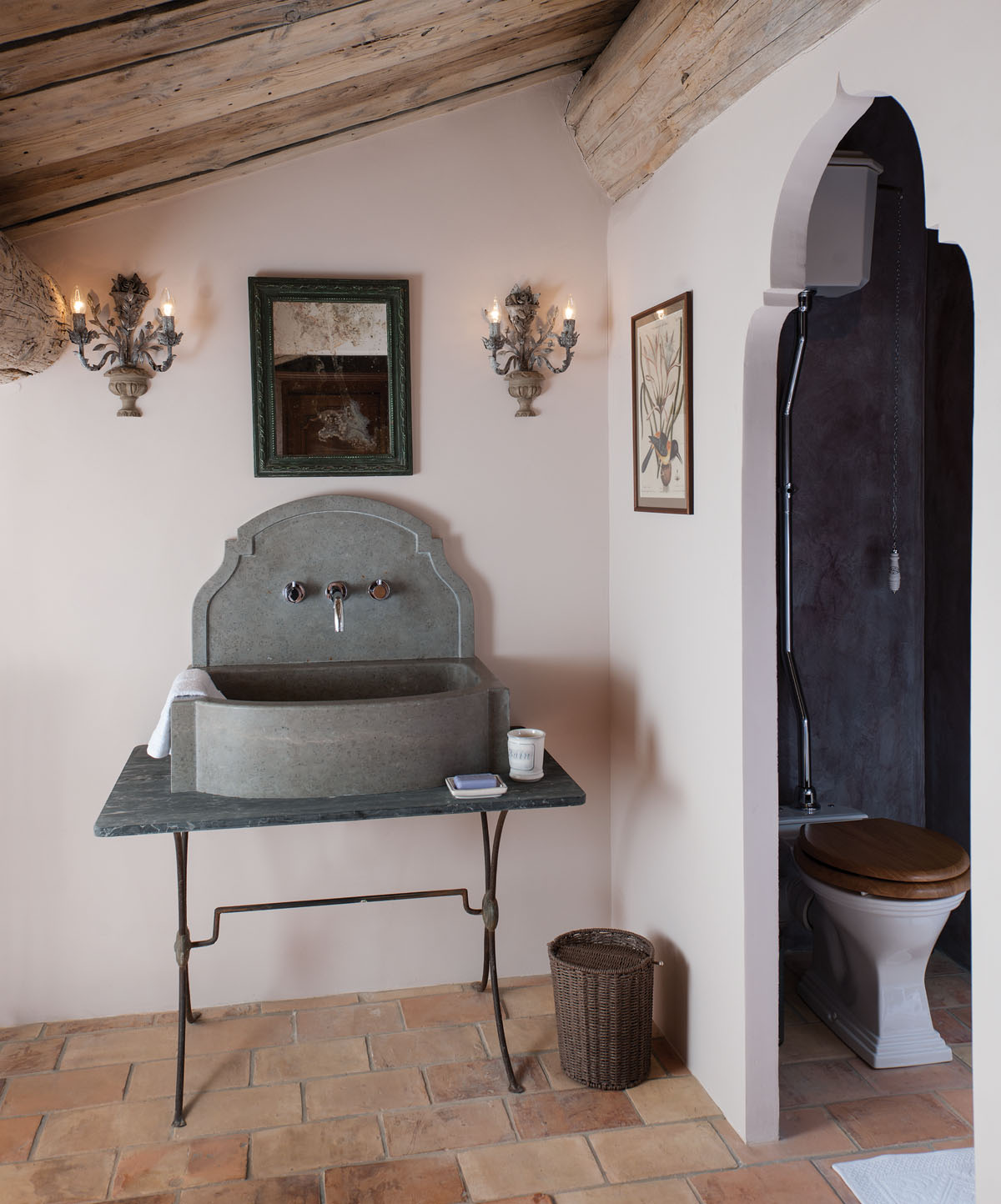
Bathrooms in France are rich in ideas, as elevating the common is a trait at which the French not only delight but also excel. For them, luxury is lavender soap and thick, freshly scented nib d’abeille towels, coveted for their exfoliating properties. In the States, we refer to the same towels as “honeycomb.”

Moody gray walls, a stone-colored headboard covered in Belgian linen and white matelassé bedding join forces to bring a modicum of romance to a guest room. Matelassé, French for “padded,” is woven on a jacquard loom, producing an embossed, quilted look.
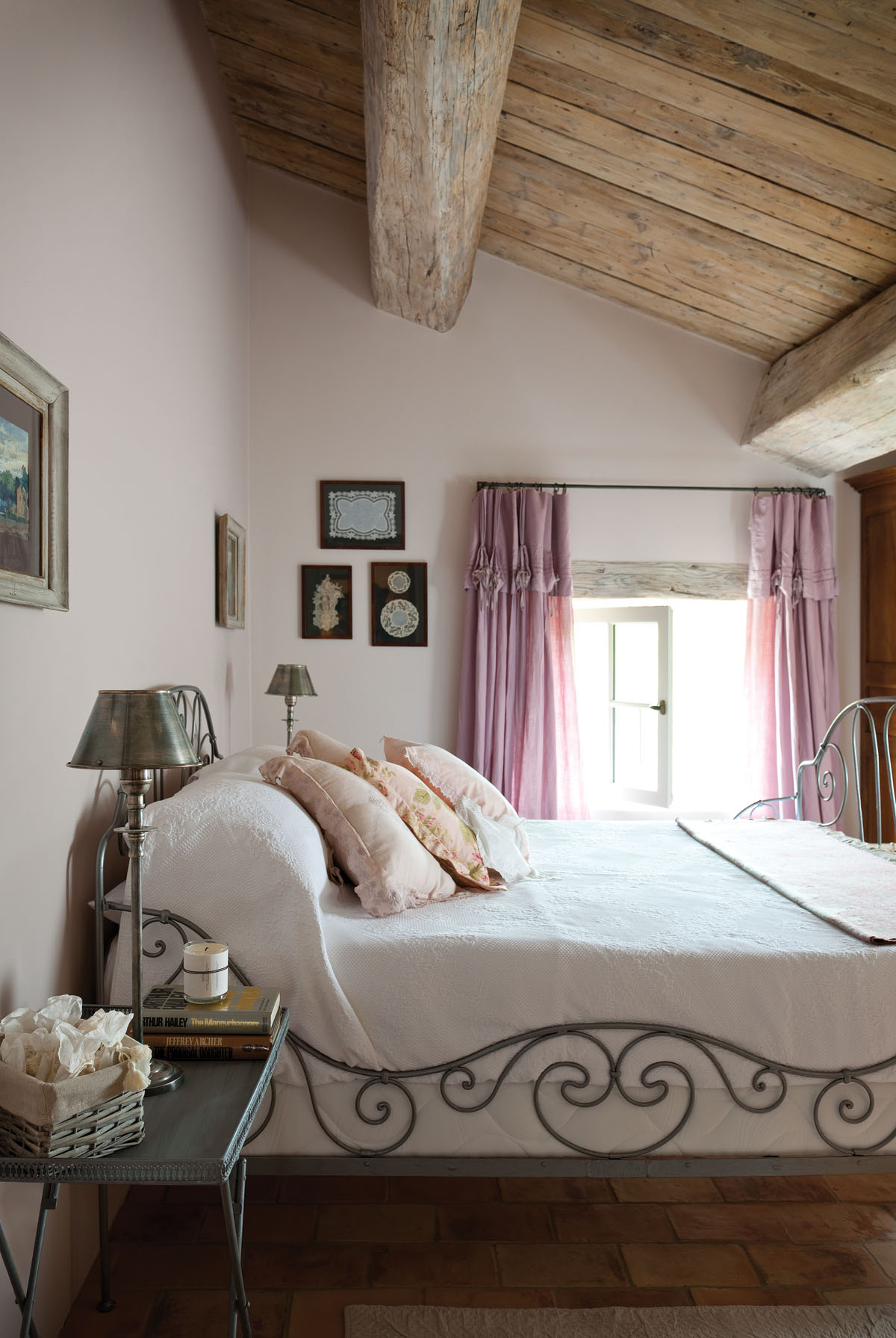
Light streams into a guest suite with an iron bed and the soft colors favored by Madame de Pompadour.